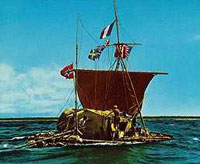 On April 28, 1947, a six-man expedition led by Thor Heyerdahl sailed from Callao, Peru aboard a balsa wood raft named the Kon-Tiki on a 101-day journey across the Pacific Ocean to Polynesia. Heyerdahl’s book, Kon-Tiki: Across the Pacific by Raft, was an international best seller and the documentary, Kon Tiki, which was directed by Heyerdahl, won an Academy Award in 1951. The Kon-Tiki raft is on display in the Kon-Tiki Museum in Oslo.
On April 28, 1947, a six-man expedition led by Thor Heyerdahl sailed from Callao, Peru aboard a balsa wood raft named the Kon-Tiki on a 101-day journey across the Pacific Ocean to Polynesia. Heyerdahl’s book, Kon-Tiki: Across the Pacific by Raft, was an international best seller and the documentary, Kon Tiki, which was directed by Heyerdahl, won an Academy Award in 1951. The Kon-Tiki raft is on display in the Kon-Tiki Museum in Oslo.
Kon-Tiki Trip Ends on Pacific Reef; Party Safe After 4,000-Mile Drift
Despite earning international fame and renown, Heyerdahl’s theory that people from South America could have settled Polynesia in pre-Columbian times, has largely fallen out of favor. Nevertheless, Heyerdahl’s style of experimental archaeology helped renew interest in Polynesian navigation and prompted opponents of his theories to mount expeditions of their own. In 1976 the replica Hawaiian sailing canoe, Hōkūleʻa, sailed from Hawaii to Tahiti to demonstrate that Polynesians could sail on the wind over long distances, rather than merely drift downwind as had the Kon-Tiki.
For Kon-Tiki Theory, Ray of Hope Is Dashed
Thnaks to Steve Phelps for pointing out the anniversary.
